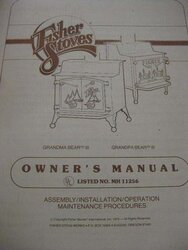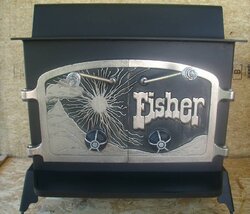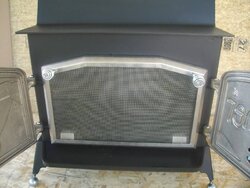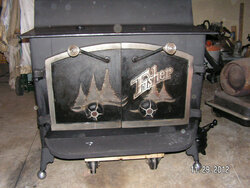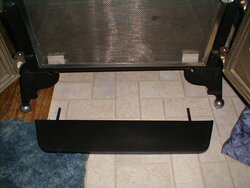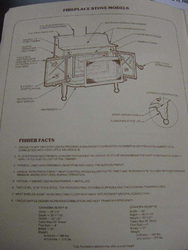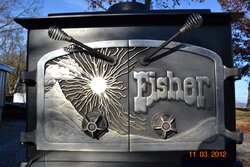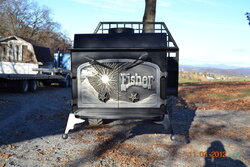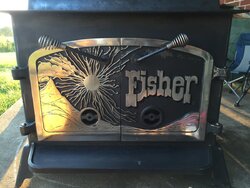I have been browsing through the various Fisher threads. I am trying to identify a Fisher wood stove that looks to me like a Fisher Grandpa Bear Stove. Here are the features I noted:
1. Door handle bars are straight handles and have springs, not knobs
2. Stove has 2 doors
3. The trees on both front doors closest to the middle door edge seem to have a larger gap between them (as opposed to a shorter gap
4. There are no stars on the doors
5. From the front or side views, there is no angular bar/seam running along each of the stove's four corners down to the feet; it looks like a smooth steel box with feet welded to the bottom corner as opposed to a steel box with brackets welded along the vertical edge of each corner
I was trying to ID it so I could dig up some more information, such as heating capability, log size, and weight. It looks like a stove that would weigh something like 450+ lbs and also looks like it should easily heat 1500sq ft. I would guess it has an 8 inch flue opening.
In other words, perfect for my needs, assuming I can get it down a set of wide stairs, and that it is in decent condition. Will be getting measurements later. Any identification help would be much appreciated. Grew up with a Ponderosa insert and loved it.


I see one manual here:
https://www.hearth.com/images/uploads/fischermanual.pdf
However, this stove height is ~30.5 tall and 29.5 wide. Will hunt for more info.
1. Door handle bars are straight handles and have springs, not knobs
2. Stove has 2 doors
3. The trees on both front doors closest to the middle door edge seem to have a larger gap between them (as opposed to a shorter gap
4. There are no stars on the doors
5. From the front or side views, there is no angular bar/seam running along each of the stove's four corners down to the feet; it looks like a smooth steel box with feet welded to the bottom corner as opposed to a steel box with brackets welded along the vertical edge of each corner
I was trying to ID it so I could dig up some more information, such as heating capability, log size, and weight. It looks like a stove that would weigh something like 450+ lbs and also looks like it should easily heat 1500sq ft. I would guess it has an 8 inch flue opening.
In other words, perfect for my needs, assuming I can get it down a set of wide stairs, and that it is in decent condition. Will be getting measurements later. Any identification help would be much appreciated. Grew up with a Ponderosa insert and loved it.
I see one manual here:
https://www.hearth.com/images/uploads/fischermanual.pdf
However, this stove height is ~30.5 tall and 29.5 wide. Will hunt for more info.
Last edited:


